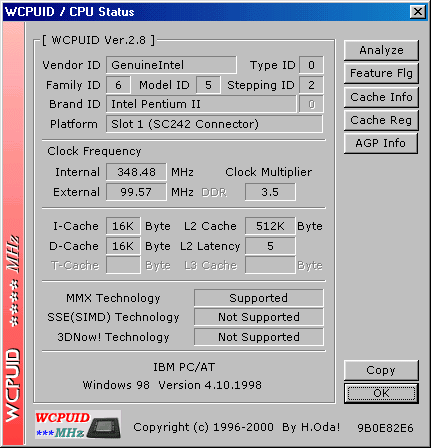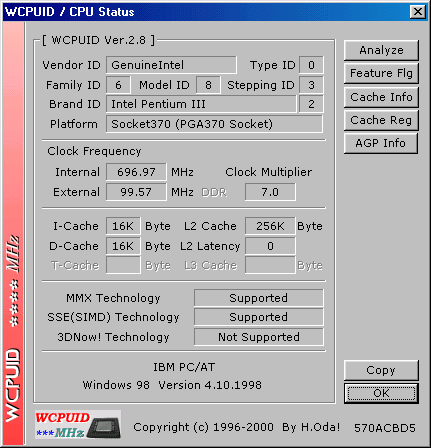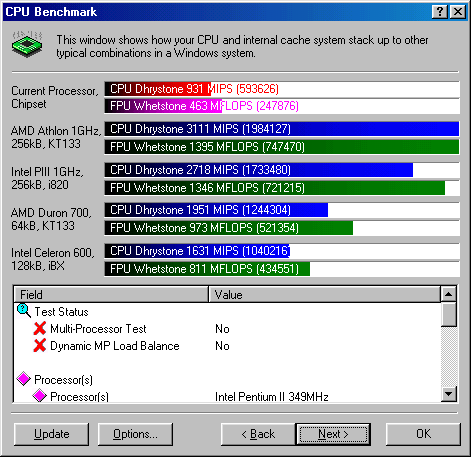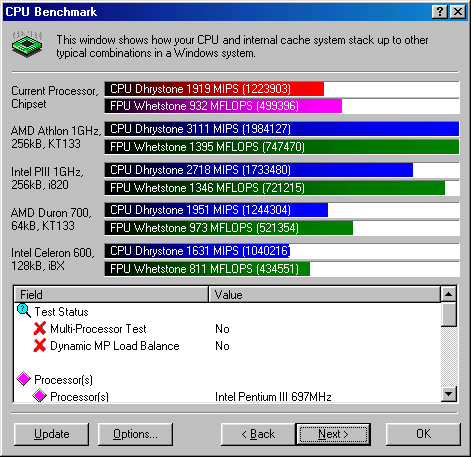| Before | After |
|---|---|
 |
 |
My Upgrade Information/Benchmarks
compiled by Robert Hancock
I chose to upgrade my XPS R350 to a Pentium III-700 FC-PGA. Why this speed? Well, the dealer I bought it from had a good deal on those processors ($Cdn 309). Even most of the slower processors were more than that. The 750 and up were quite a bit more expensive, so I just picked the 700. I picked the FC-PGA version instead of the SECC2 because the SECC2s were quite a bit more expensive and they didn't have many speeds in stock. Also, I didn't want to have to mess with getting new retention clips to lock down an SECC2 properly.
The dealer I bought from was Netlink Computers (NCIX.com) in Burnaby, BC, because there were the only Canadian dealer I could find that carried a known-to-work slocket (in this case, the Iwill Slocket II). I got the CPU from them as well because it was such a good price, plus it saved money versus paying shipping to two places.
I don't really have any complaints about the service from NCIX.com (except the fact the online order status still doesn't seem to show my order as being shipped, even though the stuff's in my computer right now!)
Here is a summary of the old and new processor information and other system information:
Old CPU: Pentium II-350 "Deschutes" - S-Spec SL2U3, Philippines
New CPU: Pentium III-700 "Coppermine" boxed processor - S-Spec SL45Y (cB0
stepping), Philippines
Slocket: IWill Slocket II, revision 1.2, automatic voltage and FSB settings
128MB RAM
Maxtor 13.6GB 5400RPM hard disk
STB NVIDIA RIVA TNT video card (running NVIDIA 6.18 reference drivers)
Turtle Beach Montego II sound card (running Aureal 2048 reference drivers)
I simply installed the CPU and slocket using the standard instructions, and everything seems to work perfectly.
First, here's the two WCPUID outputs:
| Before | After |
|---|---|
 |
 |
You can see that although the new processor has only half as much L2 cache, the latency setting is much less (0 vs. 5) which largely more than makes up for the smaller amount. The Pentium III's SSE instructions also now show up as supported.
Next, some SisSoft Sandra benchmarks:
| Before | After |
|---|---|
 |
 |
And a summary of SisSoft Sandra's other benchmarks:
| Benchmark Type | Before | After | % Increase | |
|---|---|---|---|---|
| CPU Benchmark | CPU | 931 MIPS | 1919 MIPS | 106% |
| FPU | 463 MFLOPS | 932 MFLOPS | 101% | |
| CPU Multimedia Benchmark | Integer MMX | 1040 it/s | 2180 it/s | 110% |
| Floating Point | 485 it/s | 2902 it/s | 498% | |
| Memory Benchmark | ALU/Mem | 210 MB/s | 256 MB/s | 22% |
| FPU/Mem | 250 MB/s | 279 MB/s | 12% |
You can see that there is a major increase in all CPU benchmarks, especially the CPU Multimedia Benchmark floating point, because the Pentium III's SSE instructions provide a major boost here. The memory benchmark does not increase much because this depends more on the type of memory used, the system chipset and front-side bus speed than on the processor.
Some benchmarks from ZD WinBench 99:
| Benchmark | Before | After | % Increase |
|---|---|---|---|
| CPUmark 99 | 27.4 | 61.4 | 124% |
| FPU WinMark | 1780 | 3700 | 108% |
Again, a major increase.
Some benchmarks from 3DMark 2000:
| Benchmark | Before | After | % Increase |
|---|---|---|---|
| 3DMark Result | 1243 3DMarks | 1901 3DMarks | 53% |
| CPU Speed | 70 CPU 3DMarks | 218 CPU 3DMarks | 211% |
Finally, some Quake III Arena benchmarks:
| Benchmark | Before | After | % Increase |
|---|---|---|---|
| demo1 800x600x16 | ~36 | 39 | 8% |
| demo1 320x240x16 | ~40 | 78 | 95% |
You can see that at 800x600, the average performance is largely limited by the TNT video card (although it seems the frame rate doesn't drop as low during gameplay in some portions as it did before, so there is still some benefit at 800x600). However, previously even reducing the resolution to the lowest available, 320x240, did not increase the performance much because it was being limited by the CPU. Now the performance increases significantly.